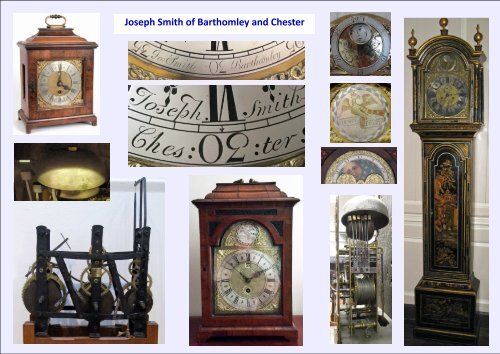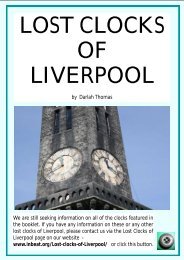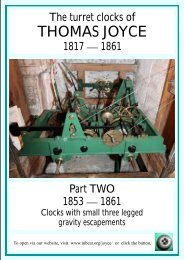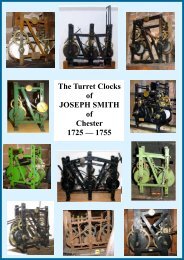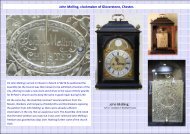Joseph Smith Clockmaker of Barthomley and Chester
Joseph Smith of Barthomley and Chester was a prolific clockmaker in the eighteenth century. Take a look at some of his clocks and read his history.
Joseph Smith of Barthomley and Chester was a prolific clockmaker in the eighteenth century. Take a look at some of his clocks and read his history.
- No tags were found...
Create successful ePaper yourself
Turn your PDF publications into a flip-book with our unique Google optimized e-Paper software.
<strong>Joseph</strong> <strong>Smith</strong> <strong>of</strong> <strong>Barthomley</strong> <strong>and</strong> <strong>Chester</strong>
<strong>Joseph</strong> <strong>Smith</strong> <strong>of</strong> <strong>Barthomley</strong> <strong>and</strong> <strong>Chester</strong><br />
<strong>Joseph</strong> <strong>Smith</strong> table clock made at <strong>Barthomley</strong><br />
<strong>Joseph</strong> <strong>Smith</strong> was a son <strong>of</strong> the well known <strong>and</strong> highly regarded<br />
clockmaker Gabriel <strong>Smith</strong> (<strong>of</strong> <strong>Barthomley</strong> <strong>and</strong> Nantwich).<br />
<strong>Joseph</strong> was born c. 1688 <strong>and</strong> learned his trade from his father. Having<br />
lived <strong>and</strong> worked in the village <strong>of</strong> <strong>Barthomley</strong> for many years, Gabriel<br />
<strong>Smith</strong> left around 1722 <strong>and</strong> relocated his business in the nearby market<br />
town <strong>of</strong> Nantwich. <strong>Joseph</strong> remained at the family home until 1725<br />
when he too left <strong>and</strong> settled in <strong>Chester</strong>.<br />
<strong>Joseph</strong> chose the Gloverstone area where he could trade as a<br />
clockmaker without the requirement to be a freeman. Gloverstone was<br />
within the old city walls, but was not subject to the city Assembly’s<br />
jurisdiction. Hence it attracted many free-spirited artisans <strong>and</strong><br />
pr<strong>of</strong>essionals. <strong>Clockmaker</strong>s were especially attracted to the area. Soon<br />
after his arrival in the city, <strong>Joseph</strong> made a three train turret clock for<br />
the cathedral which he went on to wind <strong>and</strong> maintain until infirmity in<br />
old age prevented him doing so. His wife <strong>and</strong> sons then took over.
<strong>Joseph</strong> <strong>Smith</strong> <strong>of</strong> <strong>Barthomley</strong> <strong>and</strong> <strong>Chester</strong><br />
This thirty hour longcase clock, made by <strong>Joseph</strong><br />
<strong>Smith</strong> while still living <strong>and</strong> working at <strong>Barthomley</strong>,<br />
is one <strong>of</strong> very few <strong>of</strong> this duration made by this<br />
clockmaker.<br />
It is housed in a country style oak case which may<br />
be <strong>of</strong> earlier manufacture than the clock.<br />
The clock dial <strong>and</strong> mechanism are thought to have<br />
been made around 1720.
<strong>Joseph</strong> <strong>Smith</strong> three train turret clock for <strong>Chester</strong> Cathedral<br />
<strong>Chester</strong> Cathedral Clock<br />
There was already a clock in the cathedral, which was wound<br />
<strong>and</strong> maintained by Charles Whitehead, smith <strong>and</strong> mason <strong>of</strong> the<br />
city. In September 1724, the cathedral accounts book lists<br />
£0 5s 0d spent ‘at Bargaining for a new Church clock’. This may<br />
well have been a meeting between <strong>Joseph</strong> <strong>Smith</strong> <strong>and</strong> the<br />
cathedral authorities, at which the clock was <strong>of</strong>fered as a<br />
‘master piece’. No records <strong>of</strong> any monies spent on acquiring the<br />
clock have yet been found, which could indicate that it was<br />
made as a gift. Towards the end <strong>of</strong> the following year James<br />
Comberbach, timber merchant, was paid £2 11s 0d ‘for timber<br />
for ye clock case’ <strong>and</strong> two months later Charles Whitehead<br />
received his final payment <strong>of</strong> £0 8s 0d for ‘tending ye old clock’.<br />
Even though religious communities relied on their clocks to<br />
timetable their lives <strong>and</strong> services, clocks were not highly<br />
valued. They are rarely mentioned in church histories, whereas<br />
bells are described in detail. The cathedral archives have been<br />
only partially indexed. The four account books contain the only<br />
known records relating to <strong>Joseph</strong> <strong>Smith</strong>’s clock that were<br />
written during his lifetime. All the available indexes have been<br />
searched for other references to the clock. It was customary for<br />
a clockmaker to commit to maintain a turret clock during his<br />
lifetime. This was certainly the case with the cathedral clock.<br />
<strong>Joseph</strong> <strong>Smith</strong> was paid annually, usually at Michaelmas, for<br />
maintenance <strong>of</strong> the clock. The annual salary for the job was<br />
£0 16s 0d <strong>and</strong> remained unchanged from 1727 until 1766.
<strong>Joseph</strong> <strong>Smith</strong> three train turret clock for <strong>Chester</strong> Cathedral, continued<br />
The payment was increased occasionally if repairs were required, for example<br />
one <strong>of</strong> the bells was sent to London for re-casting during the 1730s; on 18 th<br />
December 1738-9, after the bell’s return this entry was put in the accounts<br />
book: ‘To Mr <strong>Smith</strong> for cleaning <strong>and</strong> regulating the clock after the Great Bell<br />
was put up - £0 9s 0d.’<br />
<strong>Joseph</strong> <strong>Smith</strong>’s connection with the cathedral was made even closer when he<br />
sent his boys to the King’s School. The school was founded by King Henry VIII<br />
in 1541 following the dissolution <strong>of</strong> St Werburgh's Abbey, which became<br />
<strong>Chester</strong> Cathedral. It was housed in the former monastic refectory for most<br />
<strong>of</strong> the next 400 years. It was to have twenty-four poor <strong>and</strong> friendless boys<br />
aged between nine <strong>and</strong> fifteen. The boys, usually termed King's Scholars,<br />
were elected by competitive examination <strong>and</strong> received a free education <strong>and</strong><br />
an allowance. The ‘poor <strong>and</strong> friendless’ requirement must have been less<br />
stringently enforced as the years passed. <strong>Joseph</strong>’s eldest son, John was first<br />
listed as a King’s Scholar in the account book in 1733, followed by Gabriel(2)<br />
in 1735, Thomas in 1737 <strong>and</strong> Samuel in 1742. It is not known how long the<br />
boys attended the school, but Samuel was still there in 1745.<br />
In October 1744 Thomas was paid the year’s salary for taking care <strong>of</strong> the<br />
clock <strong>and</strong> the following year, Mrs <strong>Smith</strong> collected her husb<strong>and</strong>’s salary.<br />
Payments to <strong>Joseph</strong> then continued until 1763, when Gabriel(2) was paid ‘his<br />
year’s salary’. After that time, <strong>Joseph</strong> was paid for three more years, the final<br />
payment to him being on 4 th April 1766. John <strong>Smith</strong> continued the<br />
maintenance <strong>of</strong> the clock until his last salary was paid on 9 th November 1781.<br />
The <strong>Smith</strong> clock continued in service until 1872/3 when it was replaced by a<br />
flatbed Westminster chiming clock made by JB Joyce & Co. <strong>of</strong> Whitchurch.<br />
Like its predecessor, the Joyce clock had no dial, but simply told the time by<br />
full quarter chiming <strong>and</strong> striking the hours. At the time <strong>of</strong> the clock’s<br />
installation, the 1867 carillon was re-sited. It lessened the job <strong>of</strong> the<br />
bellringers, by playing the first lead <strong>of</strong> Bob Triples. The Joyce clock <strong>and</strong><br />
carillon were themselves superseded by an electric chiming mechanism<br />
which was installed in the new Addleshaw Bell Tower when it was completed<br />
in 1975.
<strong>Joseph</strong> <strong>Smith</strong> three train turret clock for <strong>Chester</strong> Cathedral, continued<br />
The <strong>Smith</strong> clock was auctioned by Christies in their sale <strong>of</strong> ’Important Clocks’<br />
on 7th December 2005.<br />
The catalogue stated:<br />
A GEORGE 1 IRON AND BRASS THREE TRAIN POSTED FRAME TURRET<br />
CLOCK JOSEPH SMITH DATED 1725.<br />
With in-line trains having rectangular section posts with splayed feet<br />
<strong>and</strong> bolted frame, oak barrels, turned iron collets, the going train<br />
with recoil anchor escapement, the quarter strike train in the centre<br />
with brass countwheel <strong>and</strong> internal brass fly, square brass signature<br />
plaque applied to the centre post engraved <strong>Joseph</strong> <strong>Smith</strong> <strong>Chester</strong><br />
1725, the hour strike train on the left side with iron countwheel <strong>and</strong><br />
external fly with iron vanes.<br />
THE FRAME: 15½in x 14in x 25in (39.5cm x 36cm x 63.5cm)<br />
Three train turret clocks from this period are particularly rare. The<br />
present example has the added rarity <strong>of</strong> having the going train on<br />
the right side as opposed to the normal position between the<br />
quarter <strong>and</strong> hour trains.<br />
This clock has no ‘drive-<strong>of</strong>f’, so has never driven a dial, indicating time<br />
by its strike <strong>and</strong> ting-tang quarters. Originally its pendulum was wall<br />
mounted.<br />
The clock has returned to <strong>Chester</strong> <strong>and</strong> is in a private collection.
<strong>Joseph</strong> <strong>Smith</strong>’s turret clocks<br />
Location Date Still working in original<br />
location?<br />
<strong>Chester</strong> Cathedral 1725 Now in a private<br />
collection<br />
St Michael’s Church, Shotwick 1726 Yes<br />
Features <strong>of</strong> interest<br />
Three train ting tang clock<br />
1¼ second pendulum<br />
St Peter’s Church, Little Budworth 1727 Yes Much <strong>of</strong> the original documentation<br />
survives.<br />
Fine small clock in good condition<br />
St Lawrence’s Church, Stoak 1732 Not working when we<br />
Single h<strong>and</strong>er<br />
visited but appears to<br />
be complete<br />
St John’s Church, <strong>Chester</strong> 1746 Replaced Three train movement<br />
Now in a private collection<br />
The ‘Rescued clock’ - Not working.<br />
Three train ting tang clock<br />
In a private collection<br />
St Mary’s Church, Tilston 1750 Yes Fine small clock in good condition.<br />
St Nicholas’ Church, Burton 1751 Yes Single h<strong>and</strong>er<br />
St Mary’s Church, Mucklestone - Yes Much altered<br />
St Alban’s Church, Tattenhall - Yes Maybe <strong>Joseph</strong>/Gabriel(1) <strong>Smith</strong><br />
Poulton Hall 1755 Moved a short distance Still owned by the same family.<br />
Single h<strong>and</strong>er<br />
Adlington Hall 1755 Replaced but safely<br />
All clock parts retained<br />
stored<br />
Pengwern Hall - Not working when we<br />
visited but apparently<br />
Requires some restoration<br />
Single h<strong>and</strong>er<br />
complete<br />
Whitmore Hall - Rusted up Still in original location
<strong>Joseph</strong> <strong>Smith</strong> ‘s Domestic Clocks made in <strong>Chester</strong> 1<br />
All <strong>of</strong> <strong>Joseph</strong> <strong>Smith</strong>s bracket <strong>and</strong> longcase clock movements have<br />
the family style screwed pillars. These are well cast with fine fins.<br />
His early dials are similar to those produced by his father at the<br />
same date, ie they have heavily engraved matted centres <strong>and</strong><br />
wheatear decoration. He utilised a sun motif <strong>and</strong> sometimes birds,<br />
as his father did. These designs are not uniform. For example the<br />
suns are not all to the same pattern. This could indicate different<br />
engravers’ styles, the same engraver, possibly <strong>Joseph</strong> <strong>Smith</strong><br />
himself, experimenting with different designs or a combination <strong>of</strong><br />
the two.<br />
The very earliest <strong>Chester</strong> made clocks were signed ‘<strong>Joseph</strong> <strong>Smith</strong>,<br />
Gloverstone’. Later dials were plain matted with no engraving or<br />
wheatear decoration. Many <strong>of</strong> <strong>Joseph</strong> <strong>Smith</strong>’s longcase <strong>and</strong><br />
bracket clocks have the Arabic minute numbers flipped vertically<br />
on the chapter ring; on some, just the 30 st<strong>and</strong>s the ‘right’ way up<br />
instead <strong>of</strong> the more common upside-down arrangement. On other<br />
clocks the 35, 30 <strong>and</strong> 25 are all flipped. We have seen this feature<br />
on a clock by Thomas Hampson, <strong>and</strong> only one other <strong>Chester</strong><br />
maker. This is Robert Jones who had a close working relationship<br />
with <strong>Joseph</strong> <strong>Smith</strong>.<br />
<strong>Joseph</strong> <strong>Smith</strong>’s turret clocks all run on smaller weights than is<br />
usual for big clocks, <strong>and</strong> similarly, his longcase clocks run with<br />
smaller weights than is usual, four pounds instead <strong>of</strong> the usual<br />
twelve pounds. We know <strong>of</strong> about thirty domestic clocks by<br />
<strong>Joseph</strong> <strong>Smith</strong>. They are almost all either eight day longcases or<br />
verge table clocks (<strong>of</strong>ten later converted to anchor).<br />
The clock was signed <strong>Joseph</strong> <strong>Smith</strong> Gloverstone<br />
It is the only one we have seen which is signed in this way
<strong>Joseph</strong> <strong>Smith</strong> ‘s Domestic Clocks made in <strong>Chester</strong> 2<br />
This clock came on the market in the USA in October 2015.<br />
<strong>Joseph</strong> <strong>Smith</strong> made many bracket clocks but this one is the first we<br />
have seen with lacquer. It probably dates to the period after 1725<br />
when <strong>Joseph</strong> moved into Gloverstone, but not later than 1740.<br />
These photos <strong>and</strong> those on the next<br />
page are here courtesy <strong>of</strong> the vendor.<br />
George Ormerod’s History <strong>of</strong> the<br />
County Palatine <strong>and</strong> City <strong>of</strong> <strong>Chester</strong>,<br />
1819, has a clear image <strong>of</strong> a family<br />
crest which resembles that in the<br />
arch <strong>of</strong> this clock. See a photo <strong>and</strong><br />
sketch <strong>of</strong> the crest on the next page.<br />
Lacquer finish table clock by <strong>Joseph</strong> <strong>Smith</strong>
The photos do not show it well, but a silver<br />
cartouche engraved with a coat <strong>of</strong> arms is in the<br />
arch. We believe these are the arms <strong>of</strong> the Egerton<br />
family whose presence in Cheshire dates back over<br />
a thous<strong>and</strong> years. (See sketch, right.) A branch <strong>of</strong><br />
the family lived at Oulton Park where a baroque<br />
mansion was built for John Egerton in 1716. This<br />
was in the parish <strong>of</strong> Little Budworth, Cheshire,<br />
where the church <strong>of</strong> St Peter, has a clock by <strong>Joseph</strong><br />
<strong>Smith</strong>, dated 1727, the agreement for which was<br />
signed by John Egerton <strong>and</strong> the clockmaker. The<br />
mansion burned down in 1926; the grounds now<br />
house a motor racing circuit. We believe the<br />
bracket clock was made for John Egerton.
During autumn 2014, we heard from a<br />
collector who had bought a bracket<br />
clock made by <strong>Joseph</strong> <strong>Smith</strong>. It is a<br />
timepiece, with Knibb-type repeat.<br />
When a cord is pulled, the last hour is<br />
struck, followed by the last quarter<br />
(ting tang). It was probably made<br />
during the period between 1725 <strong>and</strong><br />
1740.<br />
<strong>Joseph</strong> <strong>Smith</strong> ‘s Domestic Clocks made in <strong>Chester</strong> 3<br />
The image far right shows the clock<br />
after restoration; the other three<br />
images were taken before any work<br />
was done.<br />
Thanks to the generosity <strong>of</strong> the owner,<br />
we are able to include these images.<br />
<strong>Joseph</strong> <strong>Smith</strong><br />
table clock
<strong>Joseph</strong> <strong>Smith</strong> ‘s Domestic Clocks made in <strong>Chester</strong> 4<br />
Longcase clock with rolling moon made c 1725<br />
This longcase has several features on its dial<br />
which are seen on clocks by Gabriel <strong>Smith</strong>, ie<br />
1. Wheatear engraving around the dial square<br />
2. Wheatear around the dial centre, seconds<br />
dial <strong>and</strong> calendar aperture<br />
3. Engraving around the arch <strong>and</strong> winding<br />
holes, on the moon humps <strong>and</strong> in the<br />
seconds dial centre<br />
4. Birds<br />
5. A sun<br />
6. Narrow minute b<strong>and</strong><br />
7. Early style silvered moon with stars<br />
8. Fleur de lys<br />
9. Two narrow, finely marked minute rings<br />
Unlike Gabriel’s cases which were mostly made <strong>of</strong><br />
oak, this is made <strong>of</strong> American red walnut. This<br />
timber was used on many <strong>Chester</strong> longcases <strong>of</strong><br />
the period as it was shipped into Liverpool as<br />
ballast on vessels returning from the Americas.
Longcase clock with penny moon made 1725-35<br />
held by Grosvenor Museum, <strong>Chester</strong><br />
<strong>Joseph</strong> <strong>Smith</strong> ‘s Domestic Clocks made in <strong>Chester</strong> 5 <strong>and</strong> 6<br />
Detail <strong>of</strong> penny moon made 1725-35<br />
from another dial.
<strong>Joseph</strong> <strong>Smith</strong> ‘s Domestic Clocks made in <strong>Chester</strong> 7<br />
Three train longcase clock<br />
Another <strong>of</strong> <strong>Joseph</strong> <strong>Smith</strong>'s clocks was discovered in<br />
late 2014. It is a three train, full quarter chiming<br />
longcase clock with a very fine movement <strong>and</strong><br />
beautiful walnut case. The plain matted centre <strong>of</strong> the<br />
dial is finely engraved with two flying birds.<br />
This clock was probably made during the 1740s. This<br />
is the only three train longcase by <strong>Joseph</strong> <strong>Smith</strong> we<br />
know <strong>of</strong>, despite having been interested in his clocks<br />
for at least the last twenty years.
<strong>Joseph</strong> <strong>Smith</strong> ‘s Domestic Clocks made in <strong>Chester</strong> 8<br />
<strong>Joseph</strong> <strong>Smith</strong> two train table clock with alarm <strong>and</strong> five minute repeat<br />
From the Bonhams’ catalogue ‘Fine Clocks’ auction, 11 July 2018.<br />
Lot 59 A FINE AND RARE MID 18TH CENTURY FIVE-MINUTE REPEATING MAHOG-<br />
ANY TABLE CLOCK WITH ALARM, MOON PHASE INDICATION AND EXHIBITION<br />
PROVENANCE<br />
<strong>Joseph</strong> <strong>Smith</strong>, <strong>Chester</strong>.<br />
The bold h<strong>and</strong>le over a stepped moulded caddy with gadrooned border over outset<br />
corners with reeded <strong>and</strong> carved Corinthian columns raised on carved ogee bases,<br />
each side with a hinged <strong>and</strong> lockable glazed door to access the movement, the 9.75<br />
inch arched brass dial with flowing foliate scroll engraved border framing the<br />
painted rolling moonphase, the rococo sp<strong>and</strong>rels enclosing the silvered Roman <strong>and</strong><br />
Arabic chapter ring with finely matted centre with alarm setting disc <strong>and</strong> chamfered<br />
date aperture, signed ‘Jos: <strong>Smith</strong>, CHESTER’ between V <strong>and</strong> VII, a lever visible in the<br />
mask by IX which sets the alarm (<strong>and</strong> in doing so, silences the hourly strike), the<br />
twin gut fusee movement with five turned finned pillars screwed through the backplate<br />
<strong>and</strong> pinned to the front, now converted to anchor escapement, with<br />
countwheel strike acting on a single bell, the alarm <strong>and</strong> repeat using three further<br />
hammers <strong>and</strong> two smaller bells, 58cms (23ins) high.<br />
Exhibited: ‘Time & Place: English Country Clocks, 1600-1840’, an exhibition by The<br />
Antiquarian Horological Society at The Museum <strong>of</strong> the History <strong>of</strong> Science, University<br />
<strong>of</strong> Oxford, 25 November 2006 - 15 April 2007. Exhibit number 43.<br />
This imposing <strong>and</strong> innovative provincial clock was one <strong>of</strong> 68 exhibits selected to<br />
show the best <strong>of</strong> provincial horology over nearly two <strong>and</strong> a half centuries. Illustrated<br />
over four pages, the clock is described in the exhibition catalogue. The alarm<br />
does not have a separate power source <strong>and</strong> so when it sounds, it strikes the number<br />
<strong>of</strong> ‘lost hours’ i.e., those that would have struck since the alarm was set. This action<br />
ingeniously brings the countwheel back into synchronization. Quarter repeating<br />
clocks were not uncommon in the mid 18th century, but five-minute repeating examples<br />
are extremely rare.
More to follow


